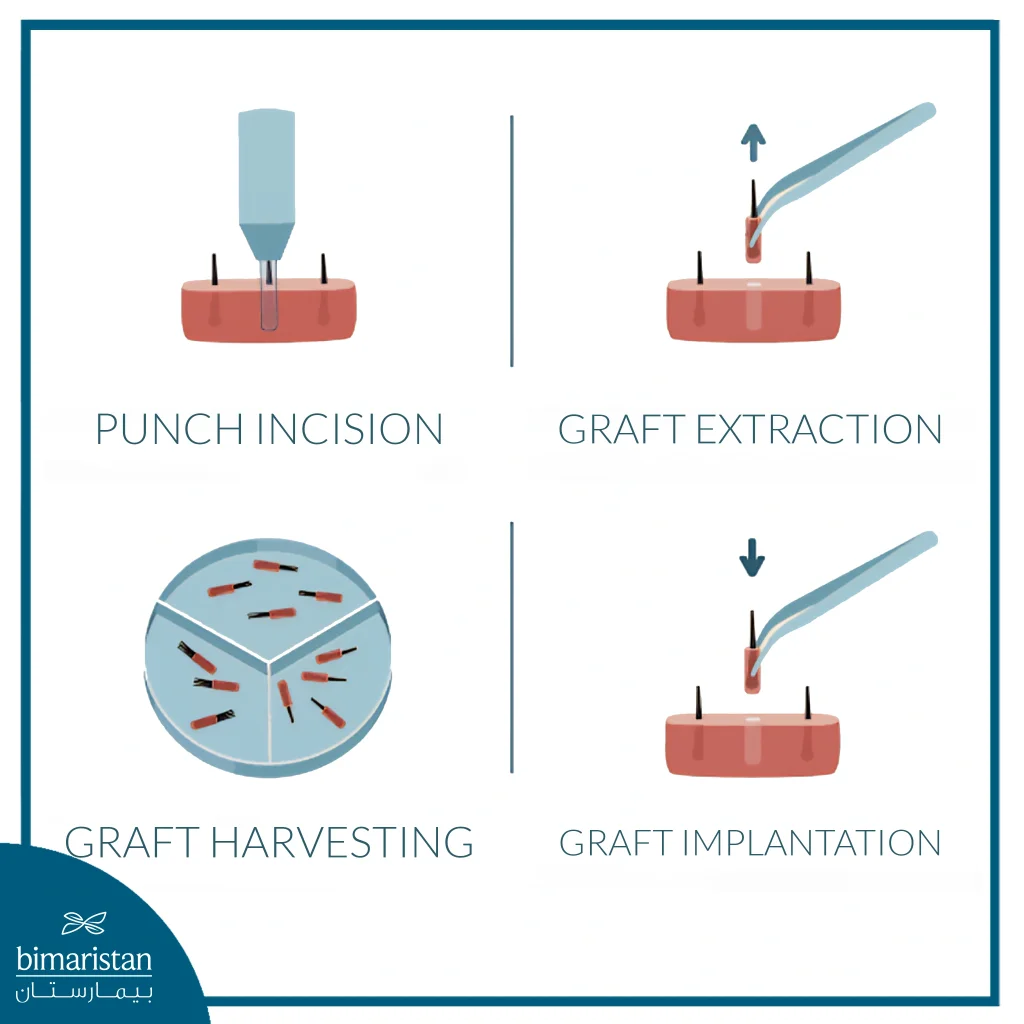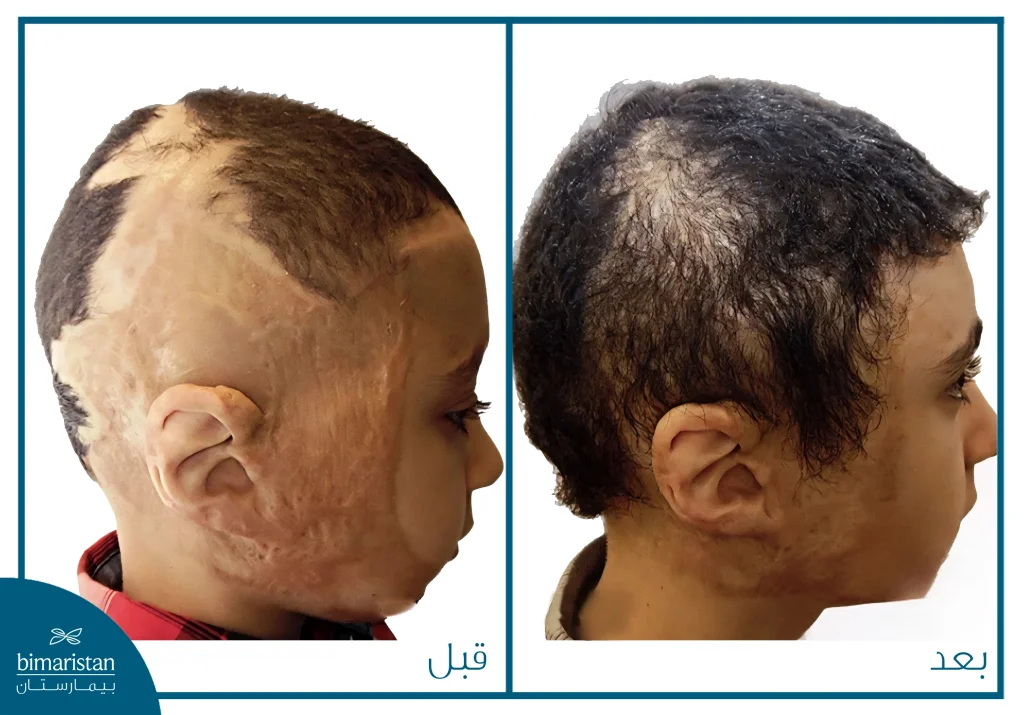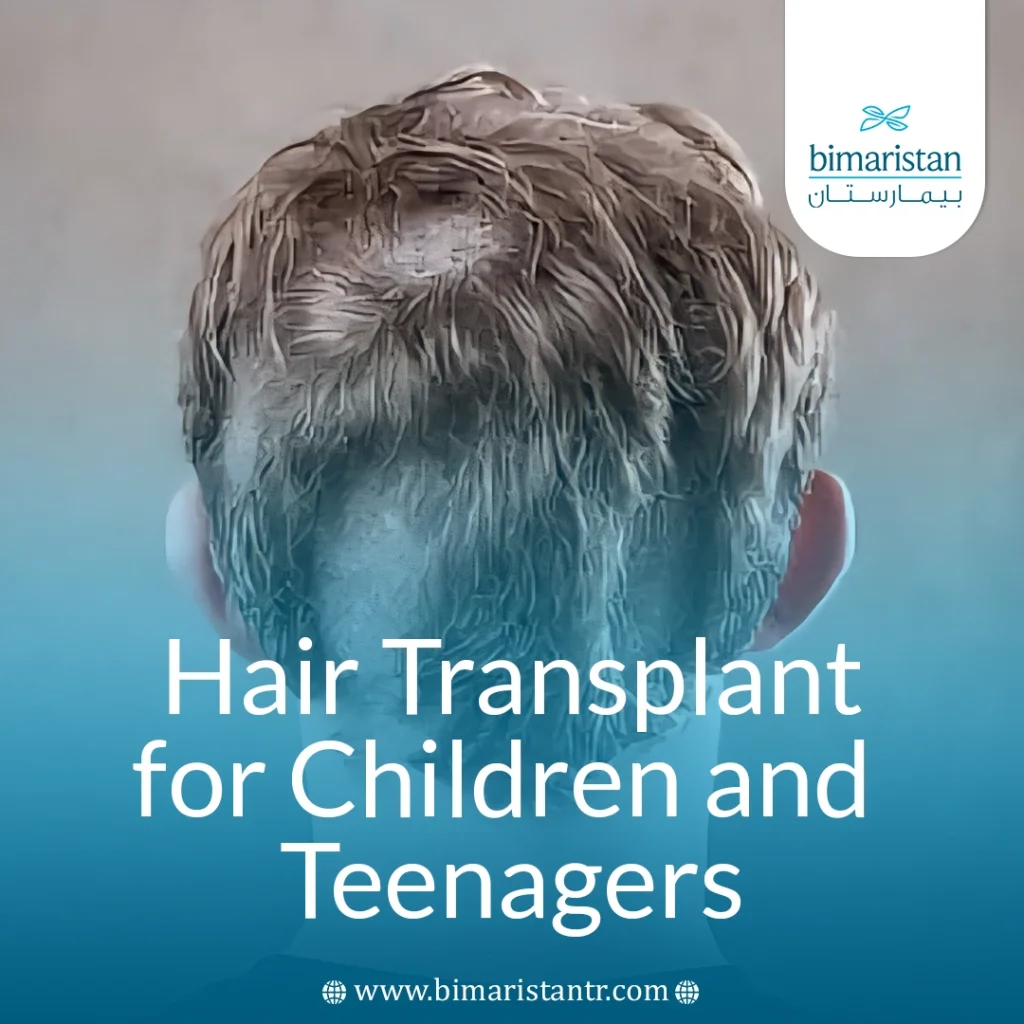Hair loss in children and adolescents is an important health and psychological issue, as it may result from multiple causes, including genetic factors, skin diseases, nutritional deficiencies, or behavioral habits. Hair loss in this age group is more than just an aesthetic issue; it can lead to significant psychological and social impacts, such as low self-confidence, embarrassment in front of peers, and a tendency to social isolation.
In cases where conventional medical or topical therapies do not achieve the desired results, hair transplants for children and teens can serve as an effective and safe solution to restore a natural look and enhance self-confidence. However, a thorough medical evaluation is essential before proceeding with any surgical intervention.
Causes of hair loss in children and teens
The causes of hair loss in children and adolescents are numerous and include:
- Genetic causes (hereditary premature baldness): Androgenetic alopecia is an inherited form of hair loss, also known as male pattern baldness or female pattern baldness. Pattern hair loss usually begins in adulthood, but it can also begin during the teenage years.
- Skin diseases: Many skin diseases cause hair loss, the most prominent of which are:
- Alopecia areata: It is an autoimmune condition that causes hair loss in patches as the immune system attacks the hair follicles.
- Tinea capitis: A common fungal infection in children that causes hair loss with bald spots.
- Psoriasis: A non-contagious autoimmune skin disease that results in skin cells growing at a faster rate than normal, which causes the formation of thick, silvery or red scales, often accompanied by itching or inflammation.
- Lack of nutrition: Poor dietary habits lead to a lack of important nutrients, such as iron and essential vitamins, and can lead to noticeable hair loss in children and adolescents.
- Wrong habits:
- Trichotillomania: This is a psychological condition in which a child feels the urge to pull out his or her hair.
- Tension-induced hair loss: It is a condition caused by constant pressure on the hair follicles as a result of tight hairstyles such as braids, ponytails, or using tight hair rollers, which causes hair loss.
- Telogen effluvium: A psychological condition caused by stress that causes hair follicles to enter a resting phase, resulting in the affected hair to suddenly fall out when combed or washed.
- Chemotherapy: Causes hair to fall out from the root while it is still growing, and some treatments that kill cancer cells can cause alopecia areata.
Are hair transplants for children and teens possible?
Hair transplants for children and teens are possible. Still, you should pay attention to the cases in which hair transplantation is contraindicated for children and teenagers, knowing the appropriate age of the child:
The right age for hair transplants for children and teens
In most cases, hair transplants for children and adolescents are not recommended until after puberty and reaching the age of 16 to 18 years, because hair follicles in children and adolescents are not fully stabilized until this period, and constantly changing hormone levels can lead to unstable results in the long run.
When hair transplants are contraindicated for children and teens
Hair transplants for children and adolescents should not be done in the following cases:
- Unstable chronic diseases: These diseases negatively affect the hair transplant process and make it unstable, such as autoimmune diseases, and there are chronic diseases that affect hair growth, such as SLE or alopecia.
- Blood clotting issues: Children with blood clotting disorders, such as hemophilia, are advised to postpone the procedure or avoid it altogether, as they may experience excessive, uncontrolled bleeding during the hair transplant and serious complications.
- Active scalp infections: These infections, such as fungal or bacterial infections, worsen the condition and increase the risk of complications after the procedure.
- Unstable psychological conditions: Conditions such as severe depression or serious behavioral disorders can affect the outcome of hair transplant surgery.
Medical examination before hair transplants for children and adolescents
Several steps and medical tests must be performed before hair transplants for children and adolescents
- A medical professional’s assessment of the causes: A medical evaluation by a medical professional aims to identify possible causes of hair loss, such as hereditary baldness, alopecia, or autoimmune diseases, and determine the best treatment option, such as whether a transplant is the best solution or if other treatments, such as medications or topical treatment, are better.
- Laboratory tests required: A range of laboratory tests is performed to ensure the patient’s health and determine the exact cause of hair loss. These tests include:
- Blood test: to check for any nutrient deficiencies or blood disorders.
- Immune examination: To determine whether there are autoimmune diseases that may affect the scalp and hair.
- Hormone testing: To check for hormonal changes that may affect hair growth, especially in teenagers.
- The importance of early diagnosis: Early diagnosis can help avoid a surgical procedure if there are other more appropriate treatment options, as well as identify the true cause of hair loss and determine whether the patient needs a hair transplant or alternative treatment.
Techniques used in Hair transplants for children and teens
There are several hair transplant techniques for children and adolescents, such as FUE and Direct Hair Implantation (DHI).
FUE hair transplant:
FUE (Follicular Unit Extraction) hair transplantation is a minimally invasive procedure to treat hair loss or baldness, by extracting healthy hair follicles from the donor area, usually the back of the head or another area, in order to transplant them into the scalp to completely cover the hairless area.
This technique is characterized by small wounds and low pain, as it uses precise tools called microbenches to extract hair follicles that contain stem cells. These follicles are soaked in a special solution before being transplanted into the scalp so that the hair becomes denser and fuller. This technique allows new hair to grow at 3 to 4 hairs per transplanted follicular unit, which gives good density and natural results, and at a lower cost than other techniques.

Direct Hair Implantation (DHI):
The DHI hair transplant technique is a modification of the FUE technique. In the FUE technique, the doctor manually makes small channels in the scalp before implanting the follicles, while in the DHI technique, the doctor uses a special pen-shaped tool with a hollow needle called choi pen, which opens the channel and implants the follicle at the same time, this tool allows precise control, resulting in more accurate hair coverage, density, fewer scars and faster recovery compared to other hair transplant techniques, and the procedure takes less time than other techniques.
Comparison between DHI and FUE in Turkey
To determine the best hair transplant technique in Turkey, it is essential to consider several key factors, including final density, recovery time, cost, and procedure duration. Below is a table showing the comparison of DHI and FUE:
| Comparison | FUE technique | DHI technique |
|---|---|---|
| Final density | Good density and natural results | Higher density, more precise implantation and better guidance for each bulb |
| Recovery time | Fast, but it takes a day or two | Slightly faster than FUE |
| Price | 15% to 30% less expensive than DHI technology | Higher due to precision tools and techniques |
| Operation time | Relatively shorter, 6-8 hours divided over several sessions | Higher density, more precise implantation, and better guidance for each bulb |
Steps of hair transplant for children and teens
Hair transplants for children and teens are done according to the following steps:
- Local or general anesthesia, depending on the situation: For younger children, procedures can be performed under general anesthesia by an anesthesiologist with extensive experience in pediatric anesthesia, providing better support for surgery.
- Follicles are harvested from the donor area: Local anesthesia is administered using 1% xylocaine diluted in saline and injected slowly over the entire donor area. The grafts are then extracted from the donor area with the help of special 0.8 and 1-mm-diameter microspinners, and the extracted grafts are preserved in saline or chilled Ringer’s lactate solution.
- Cultivation of follicular units: The follicular unit is removed using fine forceps in a non-traumatic manner and placed either directly at the recipient site or in a cryopreservation medium containing sterile, cooled saline. Once the follicular units are collected using an automated or manual bench and forceps, the donor strip is closed with a double-layer closure using sutures and staples, and the patient is moved to a sitting position for recipient site preparation and graft implantation.
- Medical follow-up after the procedure: Medical follow-up is important to ensure the safety of the results and natural recovery, such as preventing complications, removing minor scars, and evaluating hair growth.
Benefits of hair transplants for children and teens
Benefits of hair transplants for children and teens include:
- Natural and long-lasting results
- Improved appearance and self-confidence
- Avoid temporary methods such as short-term drug treatments, which may not be effective or appropriate for children in the long term

Hair transplants for children and teens: risks and complications
Side effects are usually mild and temporary, and may include:
- Minor bleeding or infection
- Need for additional surgery in the future
- The impact of early age on the stability of results
- Swelling of the scalp or bruising around the eyes
- Scabs on planting or picking sites
- Numbness or itching of the scalp
- Inflammation of hair follicles (folliculitis)
- Sudden loss of transplanted hair (a temporary natural phenomenon)
- Irregular hair growth
Alternatives for Hair transplants for children and teens
There are several alternatives to hair transplants for children and teens, including:
- Pharmacological treatments:
- Minoxidil: A topical treatment used to stimulate hair growth and reduce hair loss. Apply to the scalp twice daily.
- Finasteride: An oral medication that inhibits the DHT hormone responsible for hair loss. It is mainly used for adults.
- Platelet-rich plasma (PRP)sessions: This involves drawing a small amount of the patient’s blood, then processing it with certain substances to be injected into the scalp. These sessions help stimulate hair growth and reduce hair loss.
- Stem cell therapy: A non-surgical technique used to stimulate hair growth, it is considered effective in the early and middle stages of hair loss, but be aware that this procedure must be done under specialized medical supervision.
- Shaving or wigs as temporary solutions: This method is resorted to when other treatments are not effective or appropriate.
Recovery period and results after hair transplants for children and teens
After a hair transplant, the patient may experience mild pain in the scalp, and doctors often prescribe medications such as:
- Painkillers to relieve discomfort
- Antibiotics to minimize the risk of infection
- Anti-inflammatory medications to reduce swelling
The recovery period usually takes 7-10 days after the procedure, as small wounds heal, redness or mild swelling of the scalp fades, and most patients can return to work after several days. And it is common for the transplanted hair to fall out within two to three weeks after the procedure, which is normal to make room for new hair growth. New hair usually starts to appear in 8-12 months.
Tips to speed up and optimize hair transplant results
To speed up and optimize your recovery, you should adhere to several helpful guidelines and procedures:
- Drink enough water
- Eat a high-protein diet
- Protecting the scalp from the sun
- Avoid thermal styling tools
- Lying on a slightly elevated pillow to reduce swelling
- Follow all the doctor’s instructions and do regular medical follow-ups
- Taking supplements that support hair health, such as vitamin D, iron, zinc, and biotin
- The hair is gently washed according to the doctor’s instructions, usually 48 hours after the procedure, using an appropriate shampoo according to the hair type.
In conclusion, hair transplants for children and adolescents are an effective solution to restore hair and improve appearance and self-confidence. Still, the success of the procedure depends mainly on consulting a specialized doctor before making the decision, in addition to ensuring the suitability of the health condition and age, assessing the causes of hair loss, and examining the scalp thoroughly. By adhering to these strict medical conditions, natural and lasting results can be safely achieved.
Sources:
- Jin, F., Wang, Y., Wang, Y., Qi, H., & Wang, J. (2022). Treatment of scarring alopecia in children using follicular unit hair transplantation. Pediatric Dermatology, 39(2), 333-337
- MedlinePlus. (2016, August 5). Hair Loss. U.S. National Library of Medicine.
